Wave Propagation Characteristics and Compaction Status of Subgrade during Vibratory Compaction
Abstract
:1. Introduction
2. Test Overview
2.1. Test Equipment
2.2. Sensor Layout
2.3. Test Procedures
- (1)
- Before the start of the test, the moisture content and particle grading of the filling should be first detected.
- (2)
- After the static pressure leveling of each test area by vibratory roller, the rolling compaction is carried out according to the corresponding test conditions. A round compaction process includes two phases, rolling travel from measuring point 1 to 6, and rolling travel from measuring point 6 to 1. After each round of rolling tests is completed, the Evd test shall be conducted in the rolled area.
- (3)
- Six acceleration measuring points are arranged on the ground with a distance of 2 m between adjacent measuring points to collect the acceleration response of the filling. The field between adjacent measuring points is divided into 5 sections on average, with each section having a width of 0.4 m. As shown in Figure 3, select the middle three sections for the Evd test, and three tests are conducted on each section.
- (4)
- Synchronously collect the acceleration response of the ground and the vibratory roller, and ensure that the time between them is consistent.
3. Test Results and Analysis
3.1. Propagation of Peak Acceleration
3.1.1. Propagation Coefficient of Peak Acceleration under Different Compaction Conditions
3.1.2. Propagation Coefficient of Peak Acceleration of Vibratory Roller at Different Speeds
3.1.3. The Influence of Different Amplitudes and Frequencies on the Propagation Coefficient of Peak Acceleration during Vibratory Roller Operation
3.2. Spectrum Analysis of Acceleration Signal
3.3. Plate Load Test
4. Conclusions
- (1)
- Due to the damping of soil mass and the joint action of upper soil and lower soil mass, the peak acceleration propagation coefficient in the uncompacted state is greater than that in the compacted state at adjacent measuring points along the driving direction of the vibratory roller.
- (2)
- When the speed of the vibratory roller is 3 km/h, the acceleration propagation coefficient is greater than that at 1.5 km/h and 4.5 km/h. The speed of the vibratory roller that is most conducive to the compaction of the test-filling soil is between 1.5 km/h and 4.5 km/h. The specific value needs more detailed design test and analysis.
- (3)
- When the speed of the vibratory roller is 3 km/h, the amplitude of the fundamental wave at each acceleration measuring point reaches the maximum, while when the speed of the vibratory roller is 1.5 km/h, the amplitude of the harmonic wave at acceleration measuring point reaches the maximum. The relationship between the amplitude of the fundamental wave and the amplitude of multiple harmonic waves of each vibration wave is y = a·xb.
- (4)
- Through several rolling tests, it was found that the average Evd value of the vibratory roller under the weak vibration and the speed of 3km/h was significantly higher than the rest of the working conditions.
Author Contributions
Funding
Institutional Review Board Statement
Informed Consent Statement
Data Availability Statement
Conflicts of Interest
References
- Jayantha, K.; Tanvirul, I.; Arooran, S. Review of soil compaction: History and recent developments. Transp. Geotech. 2018, 17, 24–34. [Google Scholar]
- Proctor, R.R. Fundamental principles of soil compaction. Eng. News-Rec. 1933, 111, 55–58. [Google Scholar]
- Titi, H.H.; Tabatabai, H.; Faheem, A.; Tutumluer, E.; Peters, J.P. Spatial variability of compacted aggregate bases. Transp. Geotech. 2018, 17, 56–65. [Google Scholar] [CrossRef]
- Badakhshan, E.; Noorzad, A.; Bouazza, A.; Zameni, S. Predicting the behavior of unbound granular materials under repeated loads based on the compact shakedown state. Transp. Geotech. 2018, 17, 35–47. [Google Scholar] [CrossRef]
- Dong, L.; Pei, Z.; Xie, X.; Zhang, Y.; Yan, X. Early identification of abnormal regions in rock-mass using traveltime tomography. Engineering 2022. [Google Scholar] [CrossRef]
- Dong, L.; Tao, Q.; Hu, Q.; Deng, S.; Chen, Y.; Luo, Q.; Zhang, X. Acoustic emission source location method and experimental verification for structures containing unknown empty areas. Int. J. Min. Sci. Technol. 2022, 32, 487–497. [Google Scholar] [CrossRef]
- Dong, L.; Tong, X.; Hu, Q.; Tao, Q. Empty region identification method and experimental verification for the two-dimensional complex structure. Int. J. Rock Mech. Min. Sci. 2021, 147, 104885. [Google Scholar] [CrossRef]
- Dong, L.; Tong, X.; Ma, J. Quantitative Investigation of Tomographic Effects in Abnormal Regions of Complex Structures. Engineering 2021, 7, 1011–1022. [Google Scholar]
- Liu, D.H.; Li, Z.L.; Wang, A.G. Correlation Analysis of Rolling Parameters and Real-Time Monitoring Index for Rockfill Dam Compaction Quality Evaluation. J. Tianjin Univ. 2013, 46, 361–366. [Google Scholar]
- Long, S.; Zhong, L.L.; Hu, X.Y. Study on Compaction Signal Denoising and Continuous Compaction Index Based on Continuous Compaction Test Method. Subgrade Eng. 2018, 5, 124–127. [Google Scholar]
- Nie, Z.H.; Jiao, T.; Wang, X. Study on Continuous Compaction Indicator of Railway Subgrade Based on Harmonic Balance Identification Method. China Railw. Sci. 2016, 37, 1–8. [Google Scholar]
- Xu, G.H. Technology of Dynamic Monitor on Forming Process of Subgrade System; Southwest Jiaotong University: Chengdu, China, 2005. [Google Scholar]
- Xu, G.H.; Luo, Z.H.; Tian, B. Summary of Development of Continuous Compaction Control Technology. Road Mach. Constr. Mech. 2015, 32, 34–38. [Google Scholar]
- Imran, S.A.; Barman, M.; Commuri, S.; Zaman, M.; Nazari, M. Artificial Neural Network-Based Intelligent Compaction Analyzer for Real-Time Estimation of Subgrade Quality. Int. J. Geomech. 2018, 18, 04018048. [Google Scholar] [CrossRef]
- Ma, Y.; Zhang, Y.; Zhao, W.; Ding, X.; Wang, Z.; Ma, T. Assessment of Intelligent Compaction Quality Evaluation Index and Uniformity. J. Transp. Eng. Part B-Pavements 2022, 148, 04022024. [Google Scholar] [CrossRef]
- Ma, Y.; Luan, Y.-C.; Zhang, W.-G.; Zhang, Y.-Q. Numerical simulation of intelligent compaction for subgrade construction. J. Cent. South Univ. 2020, 27, 2173–2184. [Google Scholar]
- Lin, D. Experimental Study on the Relation between Vibration Wave’s Attenuation and Compaction Degrees; Chang’an University: Xi’an, China, 2011. [Google Scholar]
- Liu, H.H.; Liu, T.; Xin, Q.; Zheng, P.A. Model and Simulation of Roller’s Optimum Velocity Based on Material Characteristics. J. Railw. Sci. Eng. 2018, 15, 1302–1309. [Google Scholar]
- Hou, Z.; Dang, X.; Yuan, Y.; Tian, B.; Li, S. Research on Intelligent Compaction Technology of Subgrade Based on Regression Analysis. Adv. Mater. Sci. Eng. 2021, 2021, 4100896. [Google Scholar] [CrossRef]
- Wang, S.X. Study on the On-Line Inspection System of Optimum Compaction Speed of Vibratory Roller; Chang’an University: Xi’an, China, 2017. [Google Scholar]
- Ye, Y.S.; Yan, H.Y.; Cai, D.G.; Yao, J.K.; Chen, F.; Geng, L. Study on Influence of Compaction Parameters of High-speed Railway Subgrade on Evolution Characteristics of Vibration Wave. J. China Railw. Soc. 2020, 42, 120–126. [Google Scholar]
- Jia, M.; Yang, Y.; Liu, B.; Wu, S. PFC/FLAC coupled simulation of dynamic compaction in granular soils. Granul. Matter 2018, 20, 76. [Google Scholar] [CrossRef]
- Dan, H.C.; Yang, D.; Liu, X.; Peng, A.P.; Zhang, Z. Experimental investigation on dynamic response of asphalt pavement using SmartRock sensor under vibrating compaction loading. Constr. Build. Mater. 2020, 247, 118592. [Google Scholar] [CrossRef]
- Zhang, Z.; Zhou, Z.; Guo, T.; Xu, T.; Zhu, L.; Xu, F.; Chen, C.; Liu, T. A measuring method for layered compactness of loess subgrade based on hydraulic compaction. Meas. Sci. Technol. 2021, 32, 055106. [Google Scholar] [CrossRef]
- Liu, L.; Wang, F.; Sun, S.; Feng, W.; Guo, C. Nonlinear Dynamics of the Rigid Drum for Vibratory Roller on Elastic Subgrades. Shock. Vib. 2022, 2021, 9589230. [Google Scholar] [CrossRef]
- Chen, A.; Cheng, F.; Wu, D.; Tang, X. Ground vibration propagation and attenuation of vibrating compaction. J. Vibroeng. 2019, 21, 1342–1352. [Google Scholar] [CrossRef] [Green Version]
- Yang, C.; Zhang, L.; Han, Y.; Cai, D.; Wei, S. Study on the Transmission and Evolution Characteristics of Vibration Wave from Vibratory Roller to Filling Materials Based on the Field Test. Appl. Sci. 2020, 10, 2008. [Google Scholar] [CrossRef] [Green Version]
- Qu, L.M.; Ding, X.M.; Kouroussis, G.; Zheng, C.J. Dynamic Interaction of Soil and End-bearing Piles in Sloping Ground: Numerical Simulation and Analytical Solution. Comput. Geotech. 2021, 134, 103917. [Google Scholar] [CrossRef]
- Tong, X.H.; Lian, J.; Zhang, L. Damage evolution mechanism of rock-soil mass of bedrock and overburden layer slopes based on shaking table test. J. Mt. Sci.-Engl. 2022, 19, 3645–3660. [Google Scholar] [CrossRef]
- Tong, X.H.; Lian, J.; Yang, C.W.; Zhang, L. Shaking table test on dynamic damage characteristics of bedrock and overburden layer slopes. J. Test. Eval. 2022, 2, 51. [Google Scholar] [CrossRef]


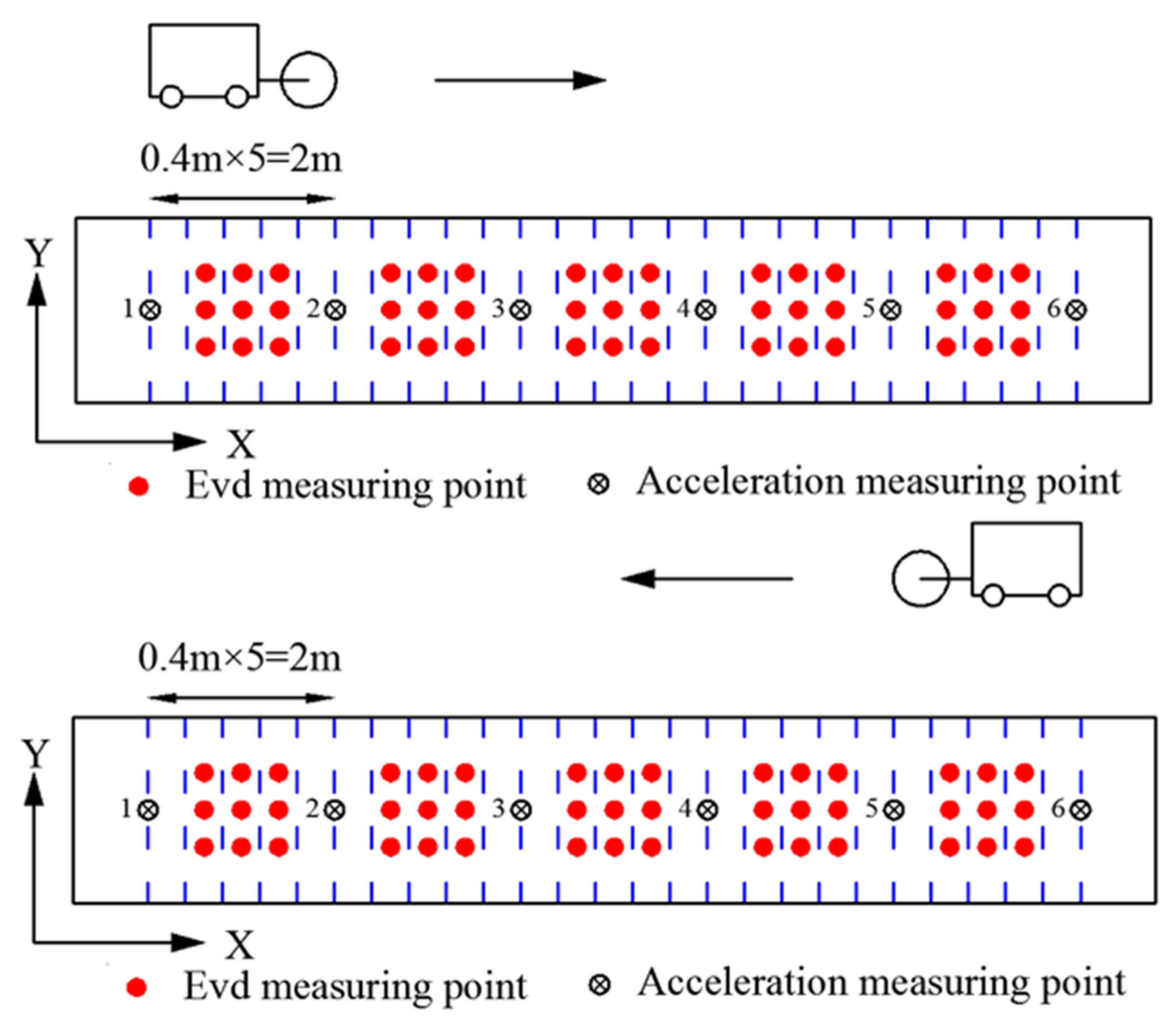
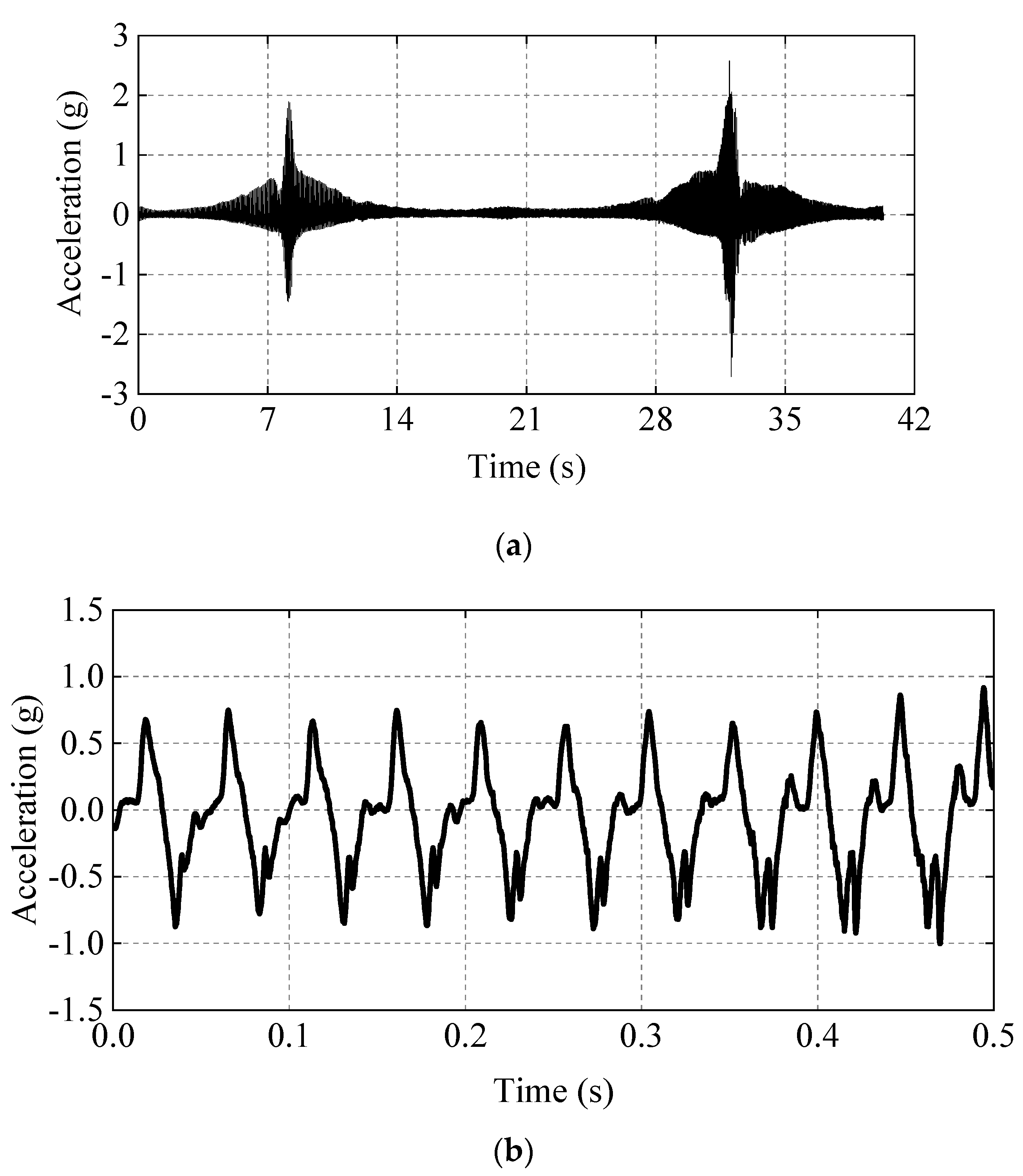

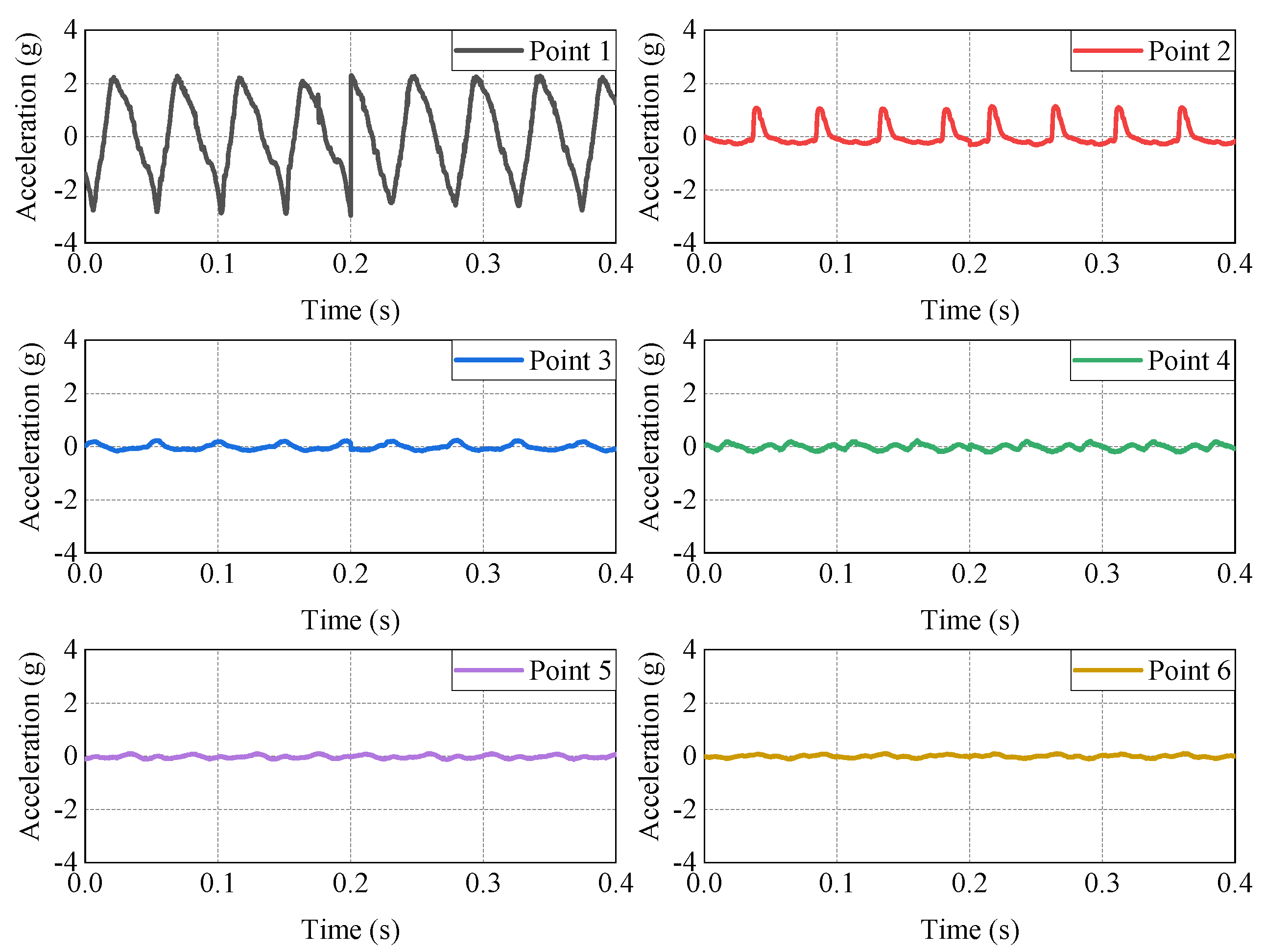

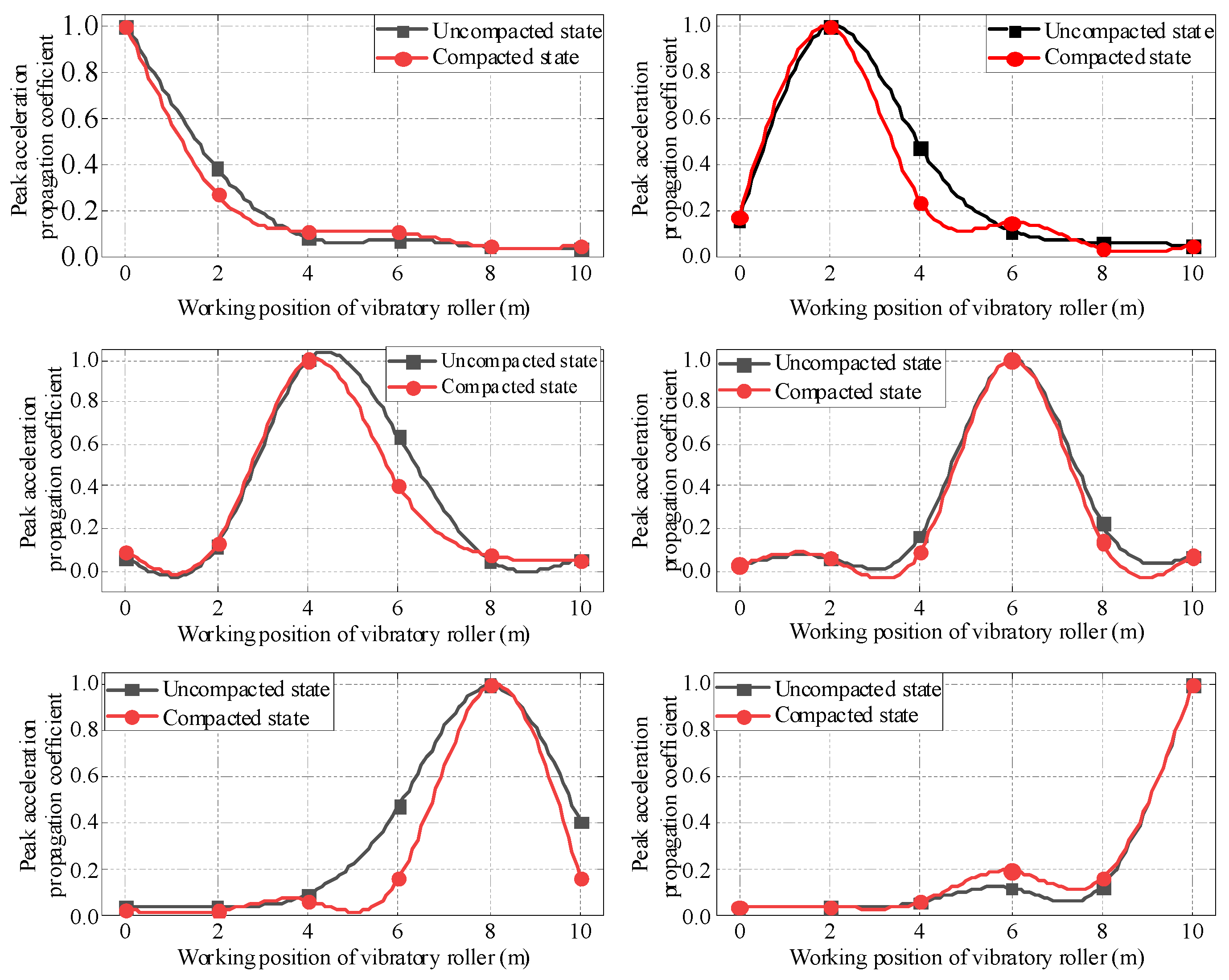
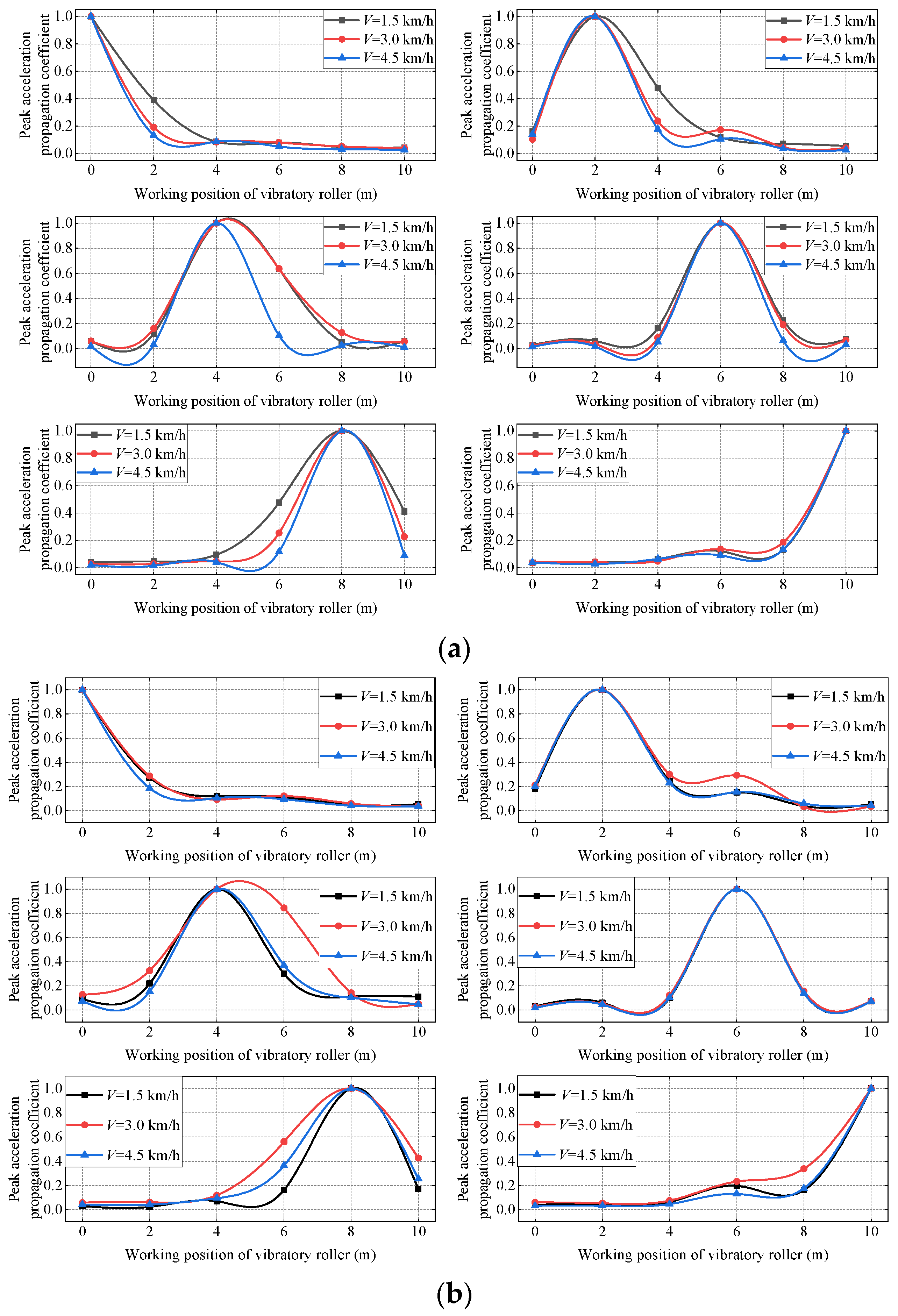
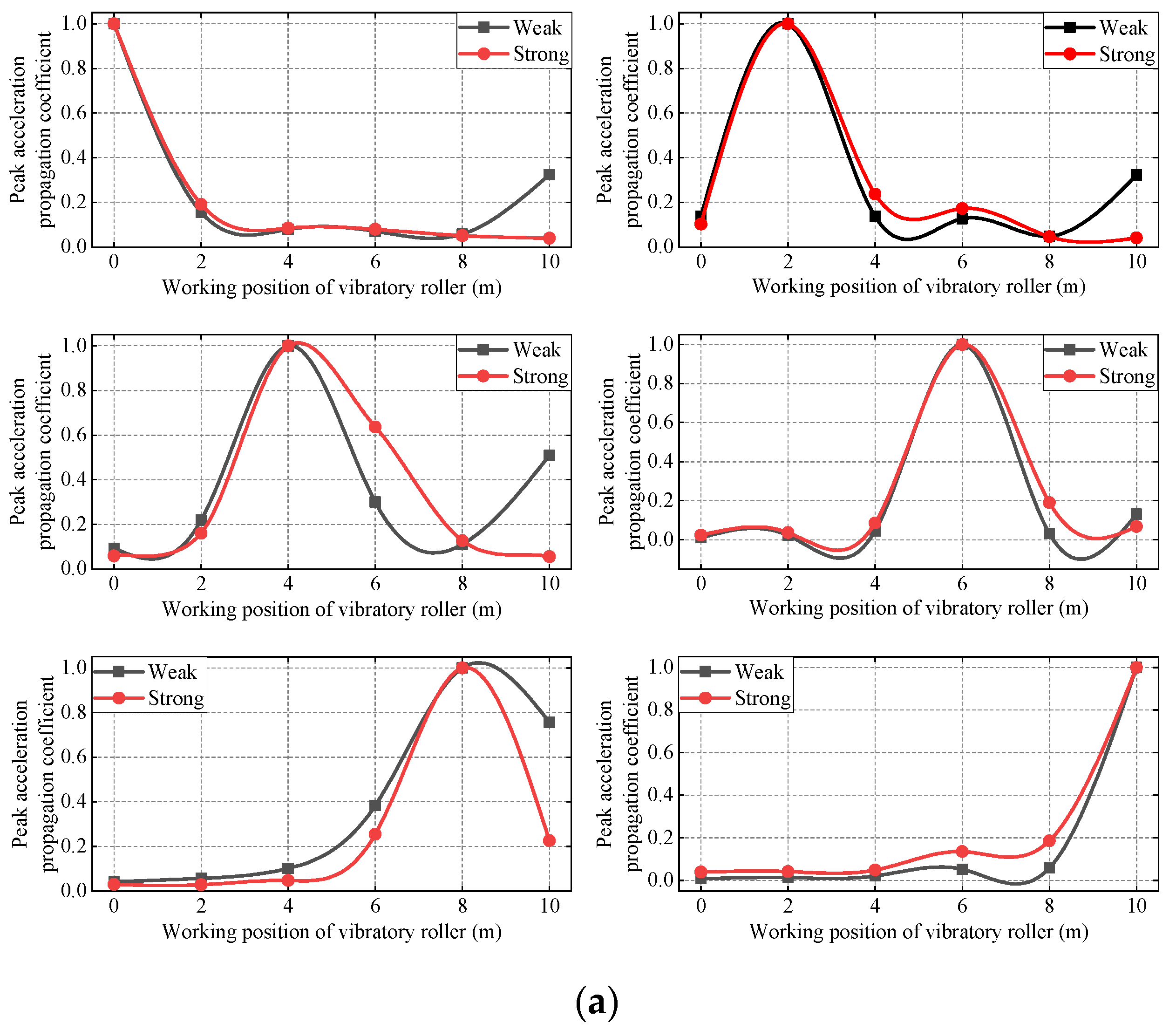
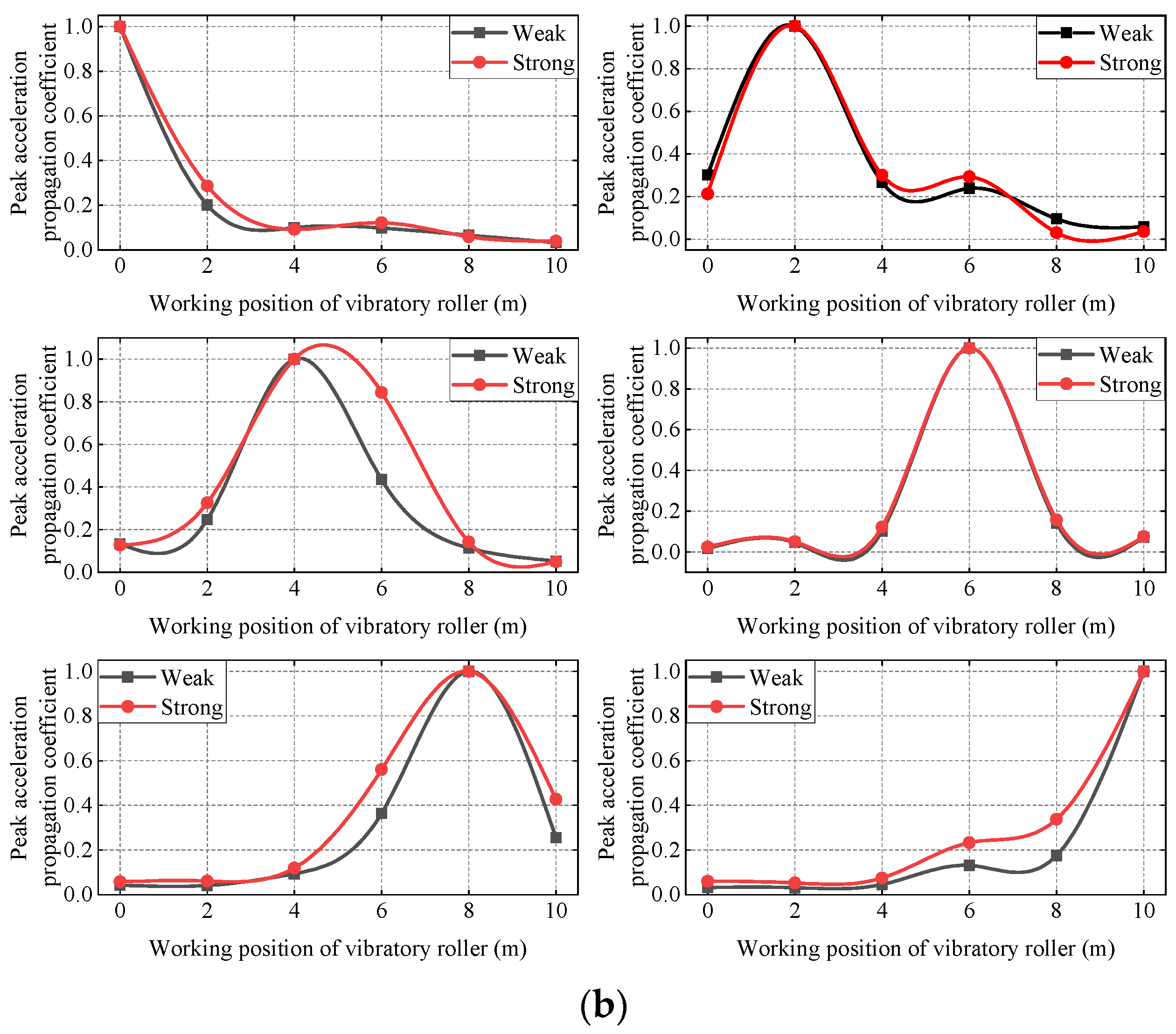
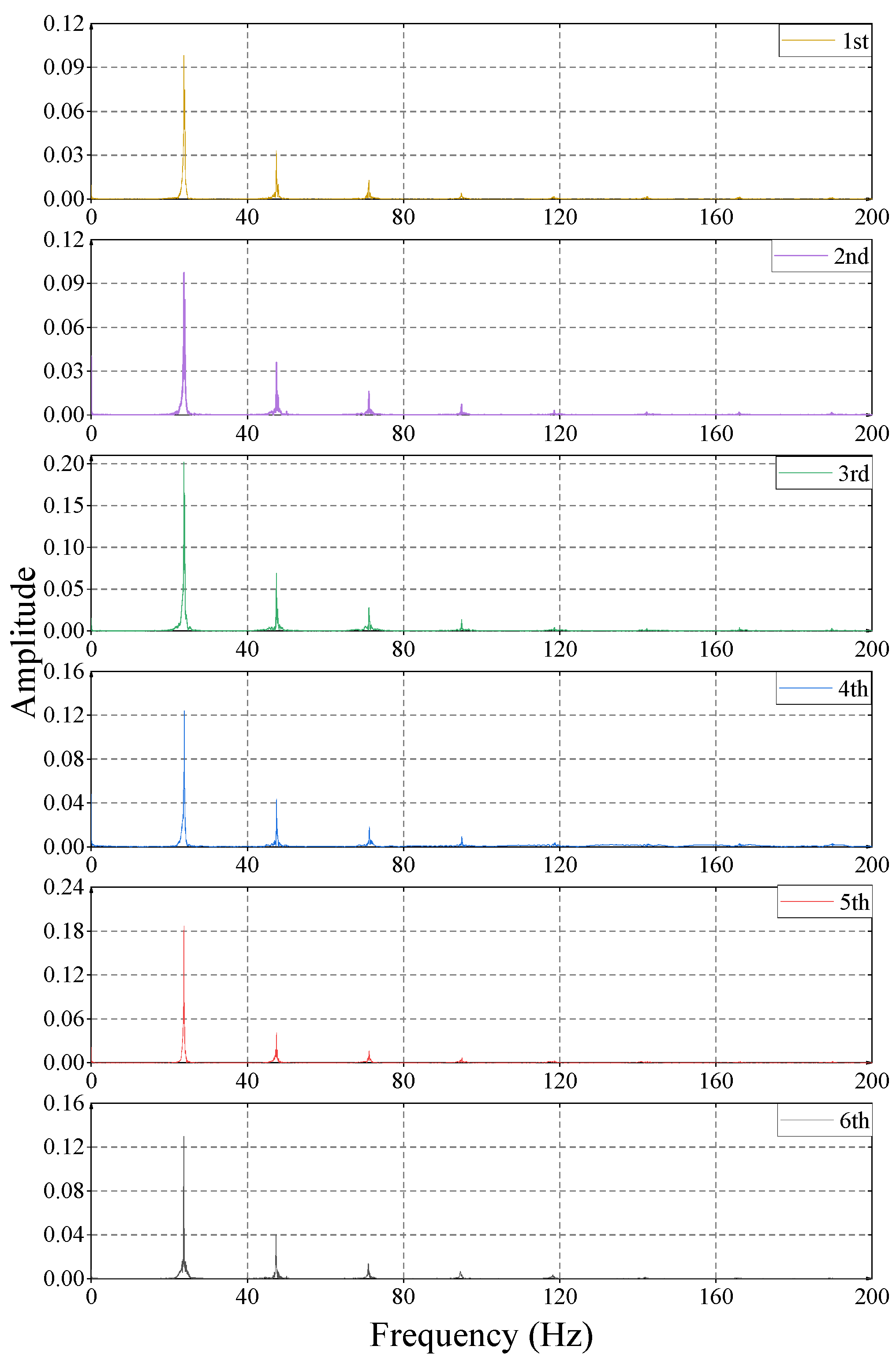

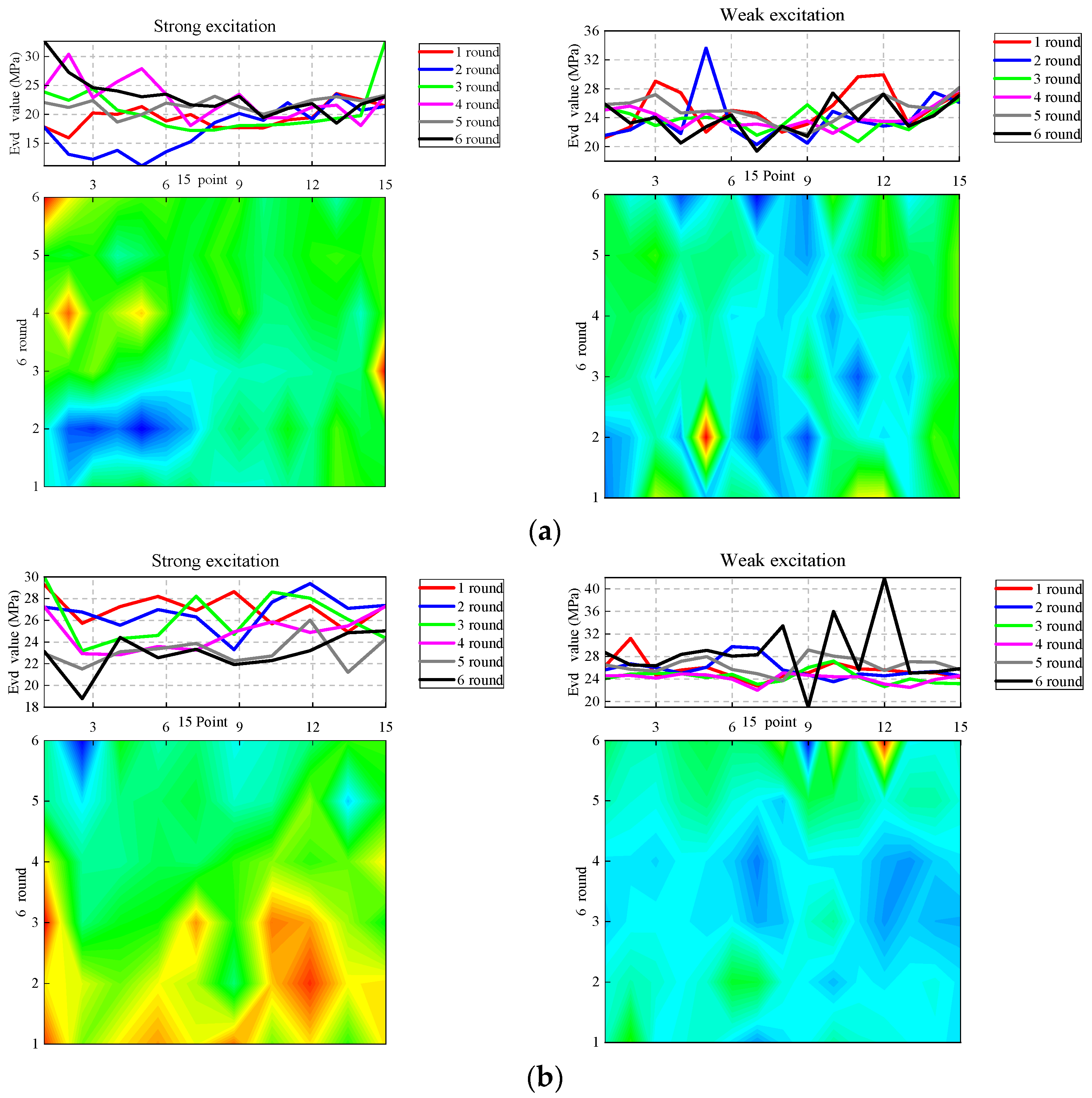
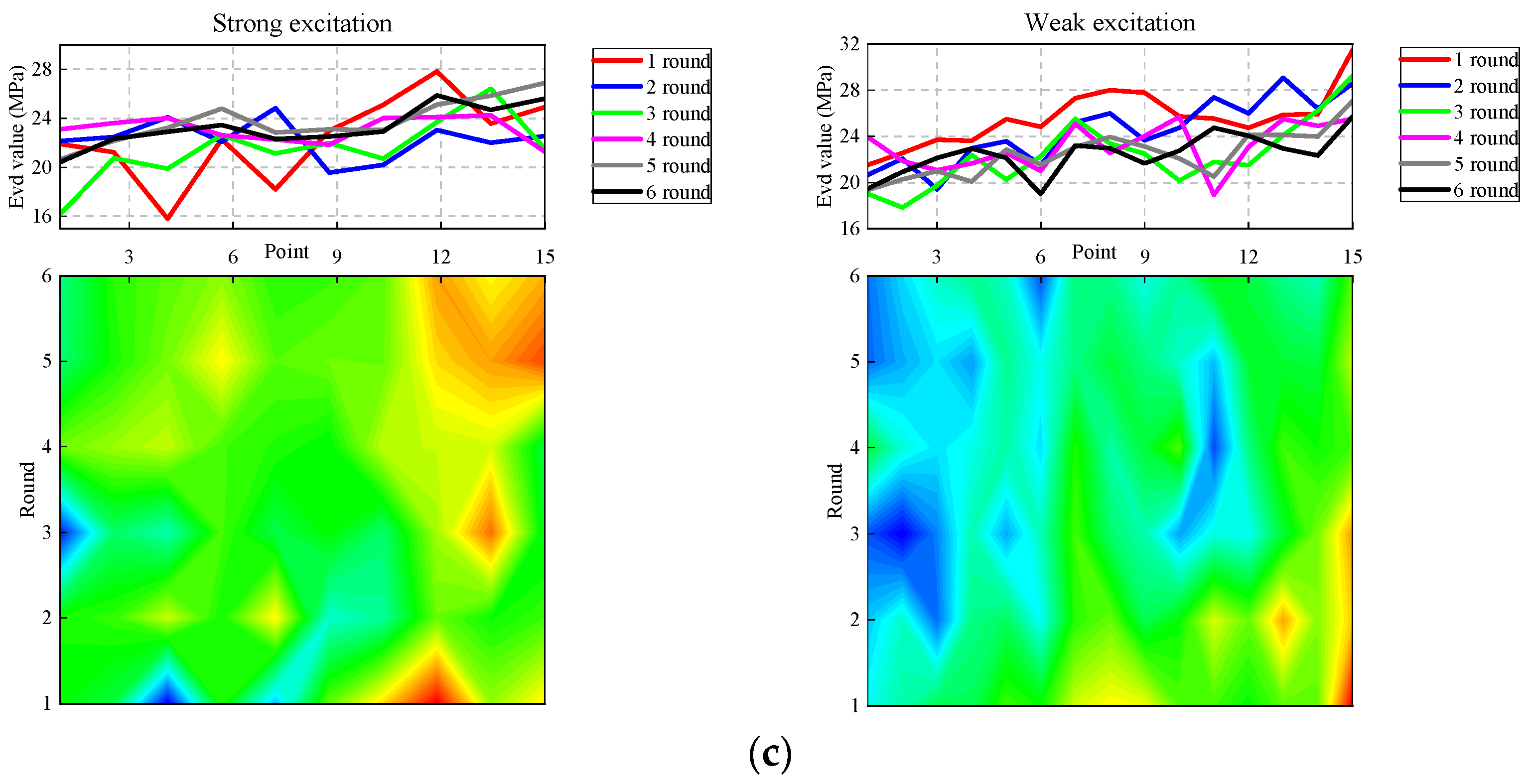
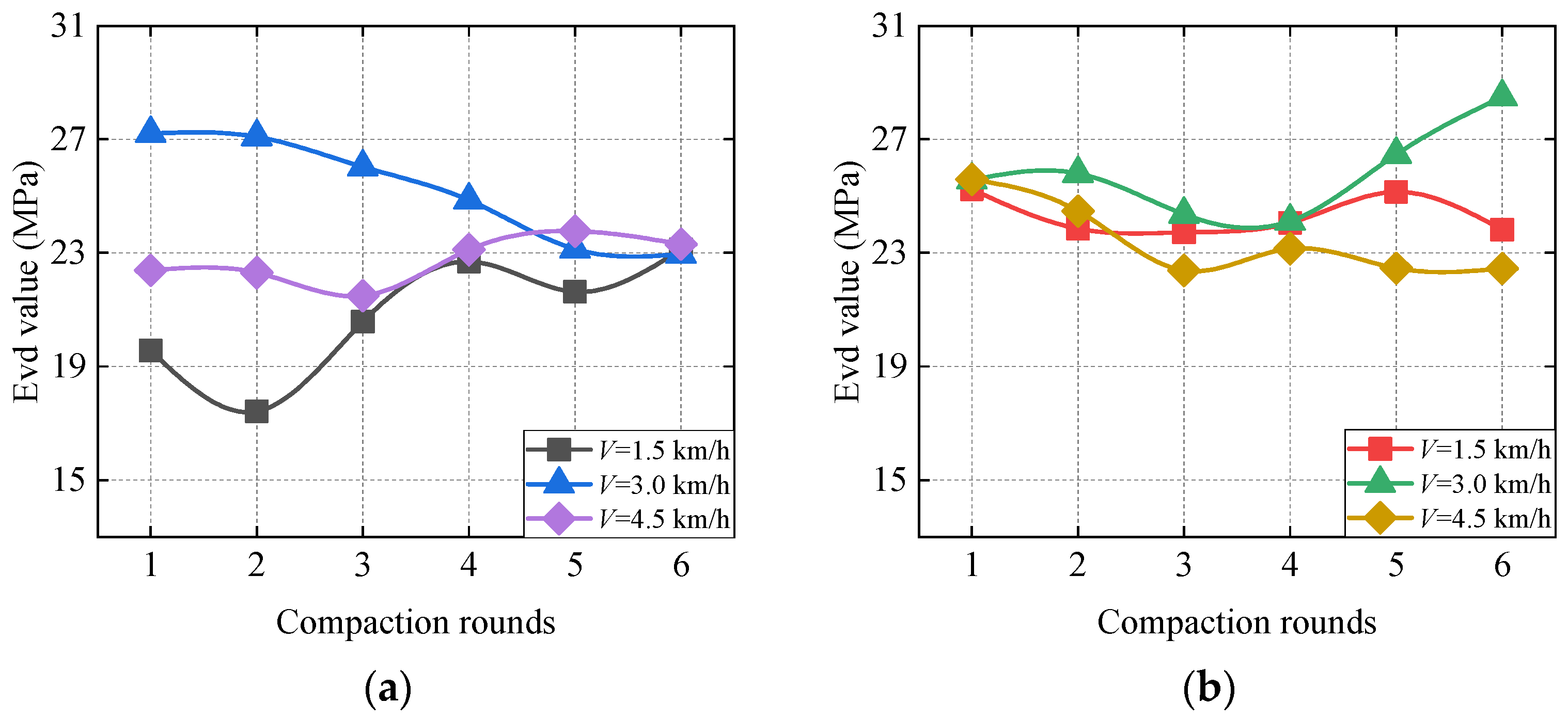
| Parameters | Working Modes | |
|---|---|---|
| Strong Excitation Weak Excitation | ||
| Exciting force (kN) | 416 | 275 |
| Nominal amplitude (mm) | 2.05 | 1.03 |
| Vibration frequency (Hz) | 27 | 31 |
| Mass (kg) | 26,700 | |
| Vibration wheel diameter (mm) | 1700 | |
| Vibrating wheel width (mm) | 2170 | |
| Case Number | Compaction Rounds | Travel Speed |
|---|---|---|
| 1 | 1 static pressure and 6 weak vibration | 1.5 km/h |
| 2 | 1 static pressure and 6 weak vibration | 3.0 km/h |
| 3 | 1 static pressure and 6 weak vibration | 4.5 km/h |
| 4 | 1 static pressure and 6 weak vibration | 1.5 km/h |
| 5 | 1 static pressure and 6 weak vibration | 3.0 km/h |
| 6 | 1 static pressure and 6 weak vibration | 4.5 km/h |
Disclaimer/Publisher’s Note: The statements, opinions and data contained in all publications are solely those of the individual author(s) and contributor(s) and not of MDPI and/or the editor(s). MDPI and/or the editor(s) disclaim responsibility for any injury to people or property resulting from any ideas, methods, instructions or products referred to in the content. |
© 2023 by the authors. Licensee MDPI, Basel, Switzerland. This article is an open access article distributed under the terms and conditions of the Creative Commons Attribution (CC BY) license (https://creativecommons.org/licenses/by/4.0/).
Share and Cite
Yao, J.; Yue, M.; Ma, H.; Yang, C. Wave Propagation Characteristics and Compaction Status of Subgrade during Vibratory Compaction. Sensors 2023, 23, 2183. https://doi.org/10.3390/s23042183
Yao J, Yue M, Ma H, Yang C. Wave Propagation Characteristics and Compaction Status of Subgrade during Vibratory Compaction. Sensors. 2023; 23(4):2183. https://doi.org/10.3390/s23042183
Chicago/Turabian StyleYao, Junkai, Mao Yue, Hongsheng Ma, and Changwei Yang. 2023. "Wave Propagation Characteristics and Compaction Status of Subgrade during Vibratory Compaction" Sensors 23, no. 4: 2183. https://doi.org/10.3390/s23042183




